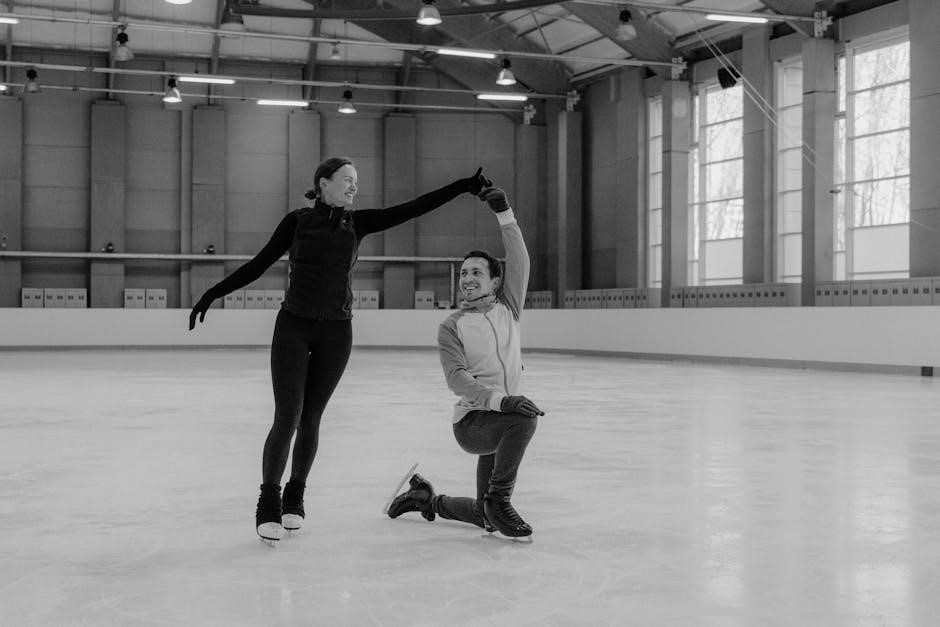The Temporomandibular Joint (TMJ) is a vital joint connecting the jawbone to the skull, enabling essential functions like chewing, speaking, and yawning. TMJ dysfunction refers to pain or limited movement in this joint, often caused by muscle imbalances, poor posture, or injury. It can significantly impact daily life, leading to discomfort, clicking sounds, and difficulty eating. Managing TMJ dysfunction through targeted exercises, lifestyle adjustments, and professional care is crucial for restoring jaw health and overall well-being. This guide provides a comprehensive approach to understanding and addressing TMJ dysfunction effectively.
What is the Temporomandibular Joint (TMJ)?
The Temporomandibular Joint (TMJ) is a synovial joint located just in front of the ear, connecting the mandible (lower jawbone) to the temporal bone of the skull. It is a complex joint that enables essential functions like chewing, speaking, and yawning. The TMJ consists of the mandibular condyle, the temporal bone, and an articular disc that separates and cushions the bones during movement; Supported by muscles and ligaments, the TMJ allows for both rotational and translational movements, making it one of the most versatile joints in the body. Proper functioning of the TMJ is crucial for oral and facial activities, and any dysfunction can lead to discomfort or pain in the jaw and surrounding areas.
Understanding TMJ Dysfunction and Its Symptoms
TMJ dysfunction occurs when the Temporomandibular Joint fails to function properly, often due to inflammation, muscle imbalances, or structural issues. Common symptoms include jaw pain, clicking or popping sounds during movement, limited jaw mobility, and tenderness in the face or temples. Some individuals may experience difficulty chewing, speaking, or opening the mouth fully. In severe cases, there may be locking of the jaw or radiating pain to the ears or neck. While mild cases may resolve on their own, persistent or severe symptoms can significantly impact quality of life, necessitating targeted exercises, lifestyle adjustments, or professional intervention to restore normal jaw function and alleviate discomfort.

Causes of TMJ Dysfunction
TMJ dysfunction arises from malalignment of jaw muscles, poor posture, teeth grinding, and jaw injuries, often exacerbated by stress and harmful habits affecting joint stability.
Malalignment of Jaw Muscles
Malalignment of jaw muscles is a primary cause of TMJ dysfunction, leading to improper jaw tracking and strain. This misalignment often stems from muscle imbalances, where some muscles become overactive while others are underactive. Prolonged habits like teeth grinding or clenching exacerbate this issue, causing inflammation and pain. Poor posture, particularly forward head posture, further disrupts jaw muscle balance. Additionally, trauma or injury to the jaw or surrounding muscles can trigger malalignment. Exercises such as isometric movements and resisted jaw exercises help restore proper muscle alignment and strength, reducing dysfunction and alleviating symptoms. Addressing muscle imbalances is crucial for long-term TMJ health and function.
Impact of Poor Posture and Habits
Poor posture and habitual behaviors significantly contribute to TMJ dysfunction, intensifying discomfort and limiting jaw function. Forward head posture, often caused by prolonged screen time, strains the jaw muscles, leading to misalignment. Additionally, habits like teeth clenching, grinding, or chewing gum can overwork the TMJ, causing inflammation. Nail biting and resting with the jaw in an unnatural position also exacerbate dysfunction. These habits disrupt the joint’s natural movement, causing pain and stiffness. Correcting posture through exercises like shoulder rolls and neck stretches can alleviate strain. Awareness and modification of harmful habits, combined with targeted exercises, are essential for improving TMJ health and preventing further complications.

Benefits of Exercises for TMJ Dysfunction
Exercises for TMJ dysfunction provide significant benefits, including pain relief, reduced inflammation, and improved jaw mobility. They strengthen jaw muscles, restore alignment, and enhance overall joint function effectively.
Relieving Pain and Reducing Inflammation
Exercises for TMJ dysfunction are designed to alleviate pain and reduce inflammation by targeting the affected muscles and joints. Gentle stretching and isometric exercises can help soothe discomfort while improving mobility. These exercises often focus on relaxing tense jaw muscles, which are a common source of pain. By relieving muscle spasms and improving blood flow, exercises can significantly reduce inflammation and restore comfort. Regular practice of these techniques can also prevent further irritation, creating a foundation for long-term relief. Combining exercises with relaxation methods, such as deep breathing, enhances their effectiveness in managing TMJ-related pain and inflammation, promoting overall jaw health and function.
Improving Jaw Mobility and Function
Exercises tailored for TMJ dysfunction aim to enhance jaw mobility and restore proper function. These exercises focus on strengthening the muscles around the joint while improving flexibility; Controlled movements, such as opening and closing the mouth slowly, help reestablish normal jaw mechanics. Strengthening exercises, like resisted jaw movements, can improve joint stability, reducing the risk of further dysfunction. Over time, consistent practice leads to better coordination of the jaw muscles, allowing for smoother, pain-free movements. Enhanced jaw mobility not only alleviates symptoms but also supports overall facial and dental health, making everyday activities like eating and speaking more comfortable and efficient.

Phase 1: Relaxation and Stretching Exercises
Phase 1 focuses on relieving muscle tension and improving joint mobility through gentle stretching and relaxation techniques. These exercises reduce pain and inflammation, preparing the jaw for further strengthening and functional movements. Gentle jaw stretches and relaxation exercises are performed multiple times daily to enhance flexibility and comfort. This foundational phase is essential for creating a stable environment for long-term recovery and improved jaw function. Consistency in these exercises lays the groundwork for progressing to more advanced movements in later phases. By addressing muscle tightness early, individuals can achieve better overall results in managing TMJ dysfunction effectively. Regular practice ensures sustained relief and gradual improvement in jaw health. This initial phase is crucial for establishing a routine that supports lasting recovery and prevents future discomfort. Through targeted stretches and relaxation, individuals can alleviate symptoms and restore normal jaw function over time. These exercises are designed to be low-impact, making them accessible for those experiencing acute pain or limited mobility. By prioritizing relaxation and flexibility, Phase 1 sets the stage for a comprehensive and effective rehabilitation process. Patients often notice improvements in jaw mobility and reduced discomfort within a few weeks of consistent practice. This phase emphasizes the importance of patience and gradual progress in achieving optimal jaw health. The combination of stretching and relaxation techniques works synergistically to address both the physical and physiological aspects of TMJ dysfunction. As individuals advance through Phase 1, they build the strength and confidence needed to tackle more challenging exercises in subsequent phases. The goal of this phase is not only to alleviate current symptoms but also to prevent future episodes of TMJ dysfunction through improved muscle balance and joint stability. By focusing on relaxation and stretching, Phase 1 provides a solid foundation for a successful and sustainable recovery journey. Regular practice of these exercises helps individuals regain control over their jaw movements and reduce dependency on external treatments. This phase is particularly beneficial for those who prefer a non-invasive approach to managing their condition. The exercises outlined in Phase 1 are simple yet effective, requiring minimal time and effort while yielding significant benefits for jaw health. They can be incorporated into a daily routine without disrupting other activities, making them ideal for individuals with busy lifestyles. The emphasis on relaxation ensures that the jaw muscles are not overstrained, allowing for a natural and gradual healing process. As a result, Phase 1 serves as a critical starting point for anyone seeking to overcome TMJ dysfunction and achieve lasting relief from associated pain and discomfort. The exercises in this phase are carefully designed to address the root causes of TMJ dysfunction while being gentle on the joints and muscles. This makes them suitable for individuals of all ages and fitness levels, ensuring that everyone can benefit from this approach. The combination of relaxation and stretching techniques promotes overall jaw well-being, making it easier to perform everyday activities without pain or restriction. By the end of Phase 1, individuals typically experience noticeable improvements in jaw mobility and a reduction in discomfort, setting them up for success in the subsequent phases of their recovery. The exercises in this phase are also beneficial for preventing future episodes of TMJ dysfunction by improving muscle balance and joint stability. Regular practice reinforces healthy jaw movements and reduces the risk of relapse. This phase is an essential step towards achieving long-term recovery and maintaining optimal jaw health. The focus on relaxation and stretching ensures that the jaw muscles are not overworked, allowing for a natural and gradual healing process. As a result, individuals can confidently progress to more advanced exercises, knowing they have a strong foundation to build upon. The simplicity and effectiveness of Phase 1 make it an ideal starting point for anyone looking to manage TMJ dysfunction through exercise. By prioritizing relaxation and flexibility, this phase provides a comprehensive approach to addressing the symptoms of TMJ dysfunction and improving overall jaw function. The exercises are easy to follow and require minimal equipment, making them accessible to everyone. This phase is particularly beneficial for those who are new to TMJ exercises or who are experiencing acute pain. The gentle nature of the exercises ensures that the jaw is not subjected to unnecessary strain, promoting a safe and effective recovery. Regular practice of these exercises helps individuals regain control over their jaw movements and reduce dependency on external treatments. This phase is also an excellent introduction to the importance of consistent practice in managing TMJ dysfunction. By establishing a daily routine of relaxation and stretching exercises, individuals can set themselves up for long-term success in managing their condition. The exercises in this phase are designed to be adaptable, allowing individuals to modify them based on their specific needs and comfort levels. This ensures that everyone can participate safely and effectively, regardless of the severity of their TMJ dysfunction. The focus on relaxation also helps reduce stress and anxiety, which can often exacerbate TMJ symptoms. By addressing both the physical and emotional aspects of TMJ dysfunction, Phase 1 provides a holistic approach to recovery. The combination of stretching and relaxation techniques works to alleviate pain, improve mobility, and promote overall jaw health. This phase is a vital component of a comprehensive treatment plan for TMJ dysfunction, offering a gentle yet effective way to manage symptoms and improve quality of life. As individuals progress through Phase 1, they can expect to experience a gradual reduction in pain and an improvement in jaw function, setting them up for continued success in the subsequent phases of their recovery. The exercises in this phase are a cornerstone of TMJ dysfunction management, providing a solid foundation for achieving long-term relief and optimal jaw health. By prioritizing relaxation and stretching, Phase 1 offers a natural and non-invasive approach to overcoming TMJ dysfunction, empowering individuals to take control of their recovery and improve their overall well-being. This phase is an essential step in the journey towards achieving lasting relief from TMJ dysfunction and restoring normal jaw function. The exercises are easy to incorporate into daily life, making them a practical solution for managing TMJ symptoms without disrupting other activities. The focus on relaxation ensures that the jaw muscles are not overstrained, allowing for a natural and gradual healing process. As a result, individuals can confidently progress to more advanced exercises, knowing they have a strong foundation to build upon. The simplicity and effectiveness of Phase 1 make it an ideal starting point for anyone looking to manage TMJ dysfunction through exercise. By prioritizing relaxation and flexibility, this phase provides a comprehensive approach to addressing the symptoms of TMJ dysfunction and improving overall jaw function. The exercises are easy to follow and require minimal equipment, making them accessible to everyone. This phase is particularly beneficial for those who are new to TMJ exercises or who are experiencing acute pain. The gentle nature of the exercises ensures that the jaw is not subjected to unnecessary strain, promoting a safe and effective recovery. Regular practice of these exercises helps individuals regain control over their jaw movements and reduce dependency on external treatments. This phase is also an excellent introduction to the importance of consistent practice in managing TMJ dysfunction. By establishing a daily routine of relaxation and stretching exercises, individuals can set themselves up for long-term success in managing their condition. The exercises in this phase are designed to be adaptable, allowing individuals to modify them based on their specific needs and comfort levels. This ensures that everyone can participate safely and effectively, regardless of the severity of their TMJ dysfunction. The focus on relaxation also helps reduce stress and anxiety, which can often exacerbate TMJ symptoms. By addressing both the physical and emotional aspects of TMJ dysfunction, Phase 1 provides a holistic approach to recovery. The combination of stretching and relaxation techniques works to alleviate pain, improve mobility, and promote overall jaw health. This phase is a vital component of a comprehensive treatment plan for TMJ dysfunction, offering a gentle yet effective way to manage symptoms and improve quality of life. As individuals progress through Phase 1, they can expect to experience a gradual reduction in pain and an improvement in jaw function, setting them up for continued success in the subsequent phases of their recovery. The exercises in this phase are a cornerstone of TMJ dysfunction management, providing a solid foundation for achieving long-term relief and optimal jaw health. By prioritizing relaxation and stretching, Phase 1 offers a natural and non-invasive approach to overcoming TMJ dysfunction, empowering individuals to take control of their recovery and improve their overall well-being. This phase is an essential step in the journey towards achieving lasting relief from TMJ dysfunction and restoring normal jaw function. The exercises are easy to incorporate into daily life, making them a practical solution for managing TMJ symptoms without disrupting other activities. The focus on relaxation ensures that the jaw muscles are not overstrained, allowing for a natural and gradual healing process. As a result, individuals can confidently progress to more advanced exercises, knowing they have a strong foundation to build upon. The simplicity and effectiveness of Phase 1 make it an ideal starting point for anyone looking to manage TMJ dysfunction through exercise. By prioritizing relaxation and flexibility, this phase provides a comprehensive approach to addressing the symptoms of TMJ dysfunction and improving overall jaw function. The exercises are easy to follow and require minimal equipment, making them accessible to everyone. This phase is particularly beneficial for those who are new to TMJ exercises or who are experiencing acute pain. The gentle nature of the exercises ensures that the jaw
Gentle Jaw Stretching Techniques
Gentle jaw stretching is a cornerstone of Phase 1 exercises, designed to relieve tension and improve mobility. Begin by opening your mouth until you feel a gentle stretch in the jaw muscles, holding for 20-30 seconds. Slowly close your mouth and repeat 5-10 times. Another technique involves placing your fingers on your jaw joint and resisting forward jaw movement. Hold for 10 seconds, then relax. These exercises target the lateral pterygoid and masseter muscles, key contributors to TMJ dysfunction. Perform them 4-6 times daily, focusing on pain-free ranges to avoid exacerbating discomfort. Gentle stretching promotes relaxation, reduces stiffness, and enhances jaw function, laying the groundwork for more advanced exercises in later phases. Consistency is key to achieving lasting relief and improved mobility.
Relaxation Exercises for Jaw Muscles
Relaxation exercises are essential for alleviating muscle tension contributing to TMJ dysfunction. Begin with masseter muscle relaxation: place your fingers on the cheekbones, gently pressing inward. Close your mouth and hold for 10 seconds, then release. Repeat 5-10 times. Another technique involves placing your tongue behind the upper teeth, pressing it backward to relax the jaw. Hold for 20 seconds and repeat 5 times. Additionally, practice diaphragmatic breathing to reduce overall tension. Inhale deeply through the nose, filling the lungs, and exhale slowly through the mouth. Perform these exercises 4-6 times daily, focusing on releasing muscle tightness without causing pain. Regular relaxation practice helps reduce muscle spasms and promotes a more balanced jaw function.

Phase 2: Strengthening Exercises
Phase 2 focuses on strengthening jaw muscles through isometric exercises and resisted jaw movements. These exercises help improve jaw stability and function, reducing dysfunction symptoms effectively.
Isometric Exercises for Jaw Strength
Isometric exercises are a cornerstone of strengthening the jaw muscles in Phase 2 of TMJ dysfunction rehabilitation. These exercises involve contracting the jaw muscles without moving the jaw, helping to build strength and stability. A common isometric exercise is the “resisted jaw closure,” where you place your fingers gently on your jaw and press against them while trying to close your mouth. Hold for 5-10 seconds and repeat 10 times. This exercise targets the masseter and temporalis muscles, improving their endurance and reducing muscle spasms. Regular practice can enhance jaw function and reduce pain associated with TMJ dysfunction. Perform these exercises 2-3 times daily for optimal results and gradually increase resistance as strength improves. Always prioritize proper technique to avoid aggravating the condition. Consulting a physiotherapist or healthcare professional is recommended to tailor exercises to your specific needs.
Resisted Jaw Movements
Resisted jaw movements are an effective way to strengthen the muscles surrounding the TMJ, improving joint stability and reducing dysfunction. To perform these exercises, place your fingers gently on your jaw. For forward resistance, press your jaw against your fingers while trying to move it forward. Hold for 5-10 seconds and repeat 10 times. For lateral resistance, apply pressure to one side of your jaw and move it toward the opposite side. This targets the lateral pterygoid muscle, crucial for side-to-side jaw movement. Perform 3 sets daily, gradually increasing resistance as strength improves. These exercises enhance muscle endurance and promote proper jaw alignment, helping to alleviate TMJ dysfunction symptoms. Always maintain controlled movements to avoid strain. Consulting a physiotherapist can help tailor these exercises to your specific needs for optimal recovery and long-term jaw health.

Phase 3: Advanced Exercises
Phase 3 focuses on controlled mouth opening, protrusion, and lateral exercises to enhance jaw coordination and stability. These advanced movements improve joint function and reduce dysfunction symptoms effectively.
Controlled Mouth Opening and Closing
Controlled mouth opening and closing exercises are designed to improve jaw mobility and coordination. Start by sitting upright with good posture. Slowly open your mouth as wide as comfortable, holding for 5-10 seconds, then close it gently. Repeat this motion 10-15 times; Focus on smooth, controlled movements without force. If pain occurs, stop immediately. This exercise strengthens the jaw muscles and enhances joint stability. Perform it 3-4 times daily for optimal results. Consistency is key to achieving long-term improvement in TMJ function and reducing stiffness. Over time, this exercise helps restore normal jaw movement and alleviates dysfunction symptoms effectively.
Protrusion and Lateral Exercises
Protrusion exercises involve moving the jaw forward while keeping the mouth closed. Sit upright, place a finger on the chin, and gently push the jaw forward until a stretch is felt. Hold for 5-10 seconds, then relax. Repeat 10 times. Lateral exercises require sliding the jaw from side to side without opening the mouth. Use a finger on the chin for resistance, moving the jaw left and right slowly. Perform 10 repetitions in each direction. These exercises improve joint alignment, reduce stiffness, and enhance lateral movement. They are particularly effective for addressing uneven jaw tracking and improving overall TMJ function. Consistent practice helps restore balanced jaw mobility and alleviates dysfunction symptoms over time.

Posture and Lifestyle Adjustments
Maintaining proper posture and avoiding habits like chewing gum or nail-biting can reduce TMJ strain. Manage stress to prevent clenching or grinding, and ensure ergonomically aligned workspace setups to promote jaw health.
Importance of Proper Posture for TMJ Health
Proper posture plays a crucial role in maintaining TMJ health by ensuring the jaw and surrounding muscles function in alignment. Poor posture, such as slouching or tilting the head forward, can strain the TMJ, exacerbating discomfort and dysfunction. Maintaining a neutral spine and keeping the head in a balanced position reduces unnecessary stress on the jaw joint. Good posture also prevents overactivation of the jaw muscles, which can contribute to pain and limited mobility. By incorporating postural awareness into daily activities, individuals can reduce TMJ strain and create a favorable environment for healing and exercise effectiveness. Regular postural checks and ergonomic adjustments further support long-term jaw health and comfort;
Diet and Nutrition Tips for TMJ Care
A balanced diet and proper nutrition play a significant role in managing TMJ dysfunction. Eating soft, non-chewy foods such as soups, yogurt, and cooked vegetables can reduce strain on the jaw joint. Avoiding hard or crunchy foods, like nuts or ice, helps prevent unnecessary stress on the TMJ. Staying hydrated is essential for joint lubrication and overall muscle function. Incorporating anti-inflammatory foods, such as fatty fish and turmeric, can help reduce swelling and pain. Additionally, chewing food evenly on both sides of the mouth promotes balanced jaw activity. Avoiding caffeine and sugary snacks, which can exacerbate muscle tension, further supports TMJ health. A mindful eating approach can significantly aid in recovery and long-term jaw comfort.

Additional Therapies and Tips
Besides exercises, massage techniques can relieve tension in jaw muscles, while heat or cold therapy reduces pain and inflammation. These complementary approaches enhance recovery and provide immediate comfort for TMJ dysfunction.
Massage Techniques for Jaw Muscles
Massaging the jaw muscles can significantly reduce tension and pain associated with TMJ dysfunction. Gentle circular motions applied to the temples and jawline help relax tightened muscles. Using fingertips, apply light pressure in an upward direction along the masseter muscle, located on the cheekbone, to release knots. Soft tissue massage techniques can improve blood flow, reduce inflammation, and promote healing. Regular massage sessions, either self-administered or performed by a professional, can complement exercises and other therapies. This holistic approach not only alleviates discomfort but also enhances the effectiveness of TMJ dysfunction exercises, contributing to long-term jaw health and overall well-being.
Heat and Cold Therapy for Pain Relief
Heat and cold therapy are effective tools for managing TMJ dysfunction pain. Applying a warm compress or heating pad to the jaw area relaxes muscles, improves blood flow, and reduces stiffness. Cold therapy, such as an ice pack wrapped in a cloth, helps numb pain and reduce inflammation. Alternate between heat and cold for 15-20 minutes, several times a day, to maximize relief. Heat therapy is ideal for muscle relaxation, while cold therapy is better for acute pain and swelling. These methods complement exercises and can be used alongside massage for enhanced comfort. Consistent use of heat and cold therapy can significantly alleviate TMJ-related discomfort and improve jaw function.

When to See a Professional
Consult a healthcare professional if TMJ dysfunction symptoms persist, worsen, or include severe pain, limited jaw movement, or unresolved issues despite self-care and exercises.
Recognizing Severe TMJ Dysfunction Symptoms
Severe TMJ dysfunction symptoms include intense, persistent pain in the jaw, ears, or face, difficulty opening the mouth wide, and significant clicking or locking of the joint. Patients may experience limited mobility, making everyday activities like chewing or speaking challenging. Additional indicators include radiating pain to the head or neck, tenderness in the jaw muscles, and visible swelling. If symptoms persist despite self-care or worsen over time, it is crucial to seek professional evaluation. A healthcare provider can assess the severity and recommend advanced treatments, such as physical therapy or splint therapy, to address underlying issues and restore jaw function effectively.
Role of Physiotherapists in TMJ Rehabilitation
Physiotherapists play a crucial role in TMJ rehabilitation by designing personalized exercise programs to improve jaw mobility and strength. They assess muscle imbalances, posture, and movement patterns contributing to TMJ dysfunction. Through manual therapy techniques like massage and joint mobilization, physiotherapists alleviate pain and stiffness. Additionally, they educate patients on proper posture, ergonomic practices, and stress management to prevent further strain. Customized exercises, such as isometric and resisted jaw movements, are often prescribed to restore normal function. By addressing both physical and lifestyle factors, physiotherapists help patients achieve long-term relief and improved jaw health, reducing reliance on medications or invasive treatments.
Consistent performance of TMJ exercises promotes long-term relief, prevents dysfunction recurrence, and maintains optimal jaw health, ensuring improved function and reduced pain over time effectively.
Long-Term Benefits of Consistent Exercise
Consistent TMJ exercises yield significant long-term benefits, including enhanced jaw mobility, reduced pain, and improved joint stability. Regular practice strengthens jaw muscles, promotes proper alignment, and minimizes inflammation. Over time, these exercises can prevent dysfunction recurrence, restore normal chewing and speaking functions, and reduce the need for medical interventions. Additionally, consistent exercise fosters better posture and reduces muscle tension, contributing to overall well-being. Patients often experience lasting relief and improved quality of life, making exercises a cornerstone of TMJ dysfunction management. By incorporating these routines into daily life, individuals can achieve sustainable jaw health and maintain optimal function for years to come.
Maintaining Jaw Health Through Regular Practice
Regular practice of TMJ exercises is essential for maintaining jaw health and preventing dysfunction recurrence. Consistent routines strengthen jaw muscles, improve joint stability, and enhance mobility. Over time, these exercises reduce muscle tension, minimize inflammation, and promote proper jaw alignment. Incorporating exercises into daily life helps maintain optimal function and reduces the risk of pain or limited movement. Additionally, regular practice fosters awareness of harmful habits, such as teeth clenching or poor posture, allowing for timely corrections. By prioritizing jaw health through consistent exercise, individuals can enjoy long-term benefits, including improved chewing, speaking, and overall comfort. Regular practice is a proactive approach to managing TMJ health effectively.

Additional Resources
Downloadable PDF guides and recommended readings offer detailed instructions and illustrations for TMJ exercises, providing comprehensive support for managing dysfunction and improving jaw health effectively.
Downloadable PDF Guides for TMJ Exercises
Downloadable PDF guides provide comprehensive instructions for TMJ exercises, offering step-by-step illustrations and detailed explanations. These resources, often authored by healthcare professionals, cover relaxation, stretching, and strengthening exercises tailored to alleviate pain and improve jaw function. They include tips on proper posture, diet, and lifestyle adjustments to support recovery. Many guides also incorporate heat and cold therapy techniques, as well as advanced exercises for controlled mouth movements. Designed for both beginners and those in later stages of recovery, these PDFs serve as invaluable tools for managing TMJ dysfunction independently. They are complemented by expert advice, ensuring a holistic approach to jaw health and long-term wellness.
Recommended Reading for Further Understanding
For deeper insights into TMJ dysfunction, several recommended readings provide extensive knowledge on its causes, symptoms, and treatment options. Books like “Temporomandibular Joint Dysfunction: A Practitioner’s Guide” by Annika Isberg and “TMJ Dysfunction Syndrome” by S. Yeo offer comprehensive overviews, including detailed exercise routines and case studies. Additionally, research papers by authors such as S.S. Ksembaev and A.N. Parkhomenko highlight the role of physical therapy and lifestyle adjustments in managing TMJ disorders. These resources are enriched with illustrations, expert advice, and practical tips, making them invaluable for patients and practitioners seeking to understand and address TMJ dysfunction effectively. They complement the exercises outlined in downloadable PDF guides, ensuring a well-rounded approach to jaw health.
